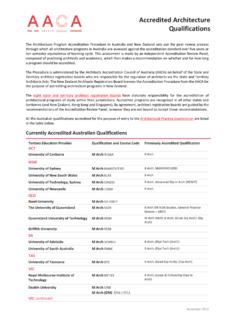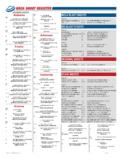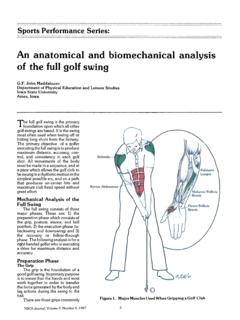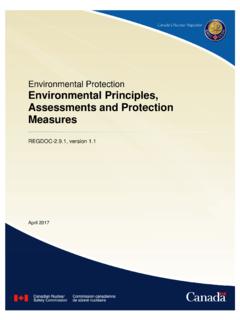Transcription of The National Standard lof Competency for Architects
1 Architects Accreditation Council of Australia 20181 The National Standard of Competency for Architects - 23 January 2018 The National Standard of Competency for Architects (2015 edition)The Architects Accreditation Council of Australia has maintained standards for the purpose of assessment processes for registration as an architect in Australia since 1990 in collaboration with the architectural sector and Australian state and territory architect registration boards. Architects Accreditation Council of Australia 20182 The National Standard of Competency for Architects - 23 January 2018 Why is it important?The National Standard of Competency for Architects identifies the primary activities and responsibilities that are fundamental to the general practice of architecture in Australia.
2 It establishes the Standard for assessment of architectural education and professional Competency prior to registration as an architect in are skilled professionals at the centre of Australia s built environment industry, a $100 billion sector employing over a million people. The built environment industry is significant for both its size and for the critical National role played by the provision of dwellings, commercial spaces, public buildings and infrastructure. (AACA s Profile of the Profession in Australia 2017)The Standard identifies for graduates, the profession and the public, the primary activities and responsibilities fundamental to the general practice of Standard is underpins across all programs of architectural education and assessment of professional Competency prior to registration as an architect in one Standard that underpins accreditation of architecture programs and Competency assessment programs provides a clear roadmap for the development of Competency on the path to registration as an National Standard of Competency for Architects describes what is reasonably expected of a person who can demonstrate the Standard of skill.
3 Care and diligence widely accepted in Australia as a competent professional Architectural practitioner. It sets out functions important to the profession of architecture, rather than simply measuring knowledge in isolation from skills, or time spent in formal education. The StandardScope of the Standard Architects Accreditation Council of Australia 20183 The National Standard of Competency for Architects - 23 January 2018 The Standard is not a form of assessment in itself but a framework to be used by those authorised to assess the professional standards of Architects but underpins all the processes that lead to the registration of Architects in Australia including the Architecture Program Accreditation Procedure in Australia and New Zealand Architecture, Overseas Qualifications Assessment, National Program of Recognition, the Architectural Practice Examination and Experienced Practitioner Assessment.
4 Each of the assessment processes listed above may require the demonstration of all or some of the part of the performance criteria described in the Standard . The context of the assessment processes is generally to the level of a Complex Project*, even though not all architectural projects follow this format, or even result in a built outcome. *Complex Project: Typically a project of medium scale or larger thatrequires the skill and knowledge to deliver the resolution and integration of complicated aspects including but not limited to: siting, planning, structure, services, materials, composition and complex project is demanding in its ordering and organisation of multiple occupancy and/or special purpose user requirements and requires the integration of cultural, social, environmental and technical Standard does not prioritise any unit, element or performance criteria.
5 Each has equal weight and all performance criteria must be demonstrated to meet the Standard as a standards facilitates flexible assessment programs on the pathway to registration as an architect. It has been organised in recognition that the path to acquiring Competency or completing registration is not necessarily linear or singular; and that that aspects of architecture require learning in the realms of both university and practice, albeit in different ways and at different levels. Architects Accreditation Council of Australia 20184 The National Standard of Competency for Architects - 23 January 2018 The Standard comprises 4 units of Competency , 11 elements and 70 performance criteria relevant to the activities of professional architectural practice.
6 It is published in an interactive format to allow individual mapping of programs against the performance criteria and also allows comparisons of the performance criteria required across programs at difference activity involving iterative explorations and appraisals of a range of ideas and concepts, leading towards the development of coherent proposals for a design process extends from the evaluation of project viability to the conceptual and schematic resolution of a project in response to client, user and public requirements. The design process for a project is informed by appropriate environmental, social and ethical considerations of the architect. Although separately listed for convenience, the sequence of design phases indicated through the Elements of Competency and Performance Criteria is not necessarily linear but often comprises overlap, repetition and process of resolving, detailing and communicating an architectural project through all project stages.
7 The modes of documentation include modelling, drawings, specifications and schedules that can be used in the construction, contract management and handover of the material must be consistent with design objectives and budgetary constraints, and must conform to relevant codes and industry standards . Where supplied by consultants, documentation compliance must be of CompetencyFormat Architects Accreditation Council of Australia 20185 The National Standard of Competency for Architects - 23 January 2018 Project DeliveryThe proficient, timely and cost-effective completion of an architectural project through all design and construction phases. Project Delivery must take into account the range of contractual obligations carried by Architects , clients, consultants and Delivery involves the evaluation and implementation of procurement systems as well as appropriate contractual administration systems.
8 The establishment and operation of project teams as well as formalising of project agreements (such as with client, team/s and contractor) is critical to competent project ManagementThe holistic understanding and organisation of the business and profession of architecture in relation to delivering projects. It involves the knowledge and execution of the processes involved in providing architectural services; the knowledge and implementation of appropriate systems to establish and maintain an architectural practice; and the knowledge and enactment of the broad range of ethical and legal obligations required of a Professional Practitioner. Architects Accreditation Council of Australia 20186 The National Standard of Competency for Architects - 23 January 2018 The 9 elements represent a set of discrete aspects of architectural practice, all of which are integral to the conception, delivery and management of architectural projects as well as to the wider creative and professional endeavours of Architects .
9 The naming and ordering of the elements does not presuppose a particular mode of practice, nor a particular sequence in which the aspects (in part or as a whole) occur. Design Project Stage Practice ManagementElementsPractice Management9. Practice ManagementThe 9 key elements of practice are supported by 70 performance criteria. Architects Accreditation Council of Australia 20187 The National Standard of Competency for Architects - 23 January 2018 The Knowledge Domains are core areas of professional knowledge and understanding that underpin architectural practice. The Knowledge Domains are weighted as either CRITICAL or NECESSARY against each Performance DomainKnowledge of the regulations, standards and codes, relevant to all aspects of architectural practice, project design and & Ethical DomainKnowledge of the social, ethical and cultural values relevant to architectural practice and the impacts on project users and broader Environment DomainUnderstanding the responsibility of Architects to minimise the impact on natural resources and design for DomainKnowledge of histories and theories relevant to architecture, practice, building and DomainKnowledge of appropriate verbal.
10 Written and visual means to communicate relevant aspects of Domains Architects Accreditation Council of Australia 20188 The National Standard of Competency for Architects - 23 January 2018 Level Required defines the level of execution required of each Performance Criteria within a three levels depict the development of Competency through the pathway to acquisition; able to demonstrate clear understanding, no requirement for application or demonstration of acquisition; able to demonstrate skill, no requirement for application in of Knowledge and Skills in architectural practice; able to demonstrate a clear understanding and demonstrate where it has been applied in architectural practice or practice RequiredKSAN ational Standard of Competency for ArchitectsThe National Standard of Competency for Architects establishes the Standard for architectural education and assessment of professional Competency prior to registration as an architect in Domain Application of Knowledge & Skills in architectural practice Regulatory Environmentally Sustainable Social & Ethical Disciplinary Communication Knowledge acquisition Skills acquisitionCritical Domain All required APE competencies are at the levelAPE LogbookAPE National Exam PaperAPE Interview Architecture Accreditation Procedure in Australia(ANZAPAP)










